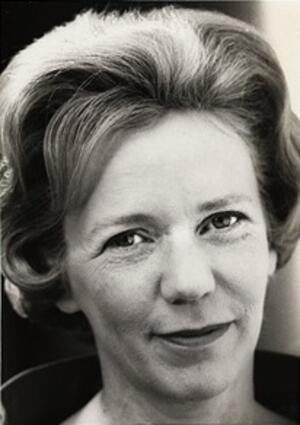Aline Saarinen
Art critic, writer, and journalist Aline Saarinen, circa 1964.
Photo courtesy of the Archives of American Art.
Aline Saarinen’s combination of creativity and plain speaking made her an unusually engaging art critic and prompted the National Broadcasting Company to make her chief of their Paris news bureau, the first woman to hold such a position. Saarinen’s career in art criticism began in print, and she rose to the position of associate art editor for the New York Times. Her career in art criticism segued into a career in television, and NBC hired her as their third woman reporter. She also served as moderator for a show called For Women Only, which addressed topics ranging from abortion to divorce. Aline Saarinen left a tremendous mark on both the art world and the world of media.
Interestingly, although Aline Saarinen served as the chief of the National Broadcasting Company’s Paris news bureau, the first woman to hold a position of this type, she did not intend to pursue a career in television. She was first and foremost an art critic.
Early Life & Education
Aline (Bernstein) Saarinen was born to two amateur painters, Allen and Irma Bernstein, in New York City, on March 25, 1914. It did not take long for her parents to take their daughter on her first of many European art tours. Her upbringing clearly encouraged her to major in art and English at Vassar College, where she served as an art critic for the college’s newspaper. Graduating in 1935 Phi Beta Kappa, she soon enrolled at New York University’s Institute of Fine Arts and received an M.A. in 1939.
During World War II, Saarinen took a few years off from the art world to play an active role on the home front. She served as executive secretary to the Allegheny County Rationing Board in Pittsburgh and as a nurse’s aide in Washington. However, the art world pulled her back, and in 1944 Saarinen contributed to Art News, thus beginning her professional career as an art critic.
Career as an Art Critic
It did not take Saarinen long to prove that she had a great deal to offer the art world. Soon after contributing to Art News, she became its managing editor. Then in 1947, Saarinen became an associate art editor for the New York Times. She served in this position until 1954 and remained with the Times as an associate art critic until 1959. While with the Times, Saarinen wrote numerous articles and reviews. In addition, in 1958, she wrote The Proud Possessors, a best-selling book that dealt with American art collectors.
Career in Television
In 1962, the Metropolitan Museum of Art exhibited Rembrandt’s “Aristotle Contemplating the Bust of Homer.” Since she had established herself as a respected critic in print, television reporters sought Saarinen’s insight on this portrait. Her television career had begun. Saarinen’s style was simple, informal, and pleasant. People liked her. Just as she rose quickly as an art critic in the world of written media, Saarinen soon gained prominence in the world of television, becoming a well-known on-air personality.
As a television art critic, Saarinen’s commentaries were both entertaining and informative. She felt that the more that people knew about art, the better off both they and the art world would be. Therefore, she examined a wide variety of topics, from Vatican art to postage stamp design. Saarinen often resorted to unorthodox means of criticism—at one point comparing a bronze sculpture of a runner to film clips of an actual sprinter. She did not hesitate to express her view on art and architecture she did not like, developing a list of the six worst human creations: the Pan Am building, Salvador Dali’s Last Supper, the typical suburban house, glass sculpture at Lincoln Center, a lamp with a violin base, and the faces on Mount Rushmore. Saarinen also had no problem cutting off individuals she interviewed if she found them to be either unexciting or too talkative.
Given Saarinen’s bold nature, it is not surprising that the National Broadcasting Company appointed her as the chief of its Paris news bureau. Furthermore, her boldness made her the perfect candidate to host For Women Only, a panel talk show that addressed questions from the audience. The show dealt with a wide range of issues, from abortion to the generation gap. As host of this program, Saarinen was not interested in being didactic. She simply wanted to arouse concern in her audience.
Personal Life & Legacy
Saarinen was married twice. Her first husband was public welfare administrator Joseph H. Loucheim, whom she married in 1935. She and Loucheim had two children, Donald and Harry. The couple divorced in 1951. Three years later, she married the Finnish architect Eero Saarinen, with whom she had one child, Eames. Eero Saarinen died in 1961.
Saarinen had the opportunity to delve into the political arena. President Lyndon B. Johnson asked the art critic to serve as ambassador to Finland, a position that certainly appealed to Saarinen given that Finland was her second husband’s homeland and a country that was concerned about its architecture. However, Saarinen turned down the president’s offer.
Aline Saarinen left a tremendous mark on both the art world and the world of the media. As a Jewish-American woman, her success opened many doors to Jews, women, and other minority groups who hoped to follow in her footsteps.
Aline Saarinen died on July 13, 1972, in New York City.
Whitman, Alden. “Aline Saarinen, Art Critic, Dies at 58.” The New York Times, July 15, 1972.
Saarinen, Aline B. The Proud Possessors. New York: Random House, 1958.
NAW Modern.
NYTimes, November 7, 1958, 25:3.
WWWIA 5.



